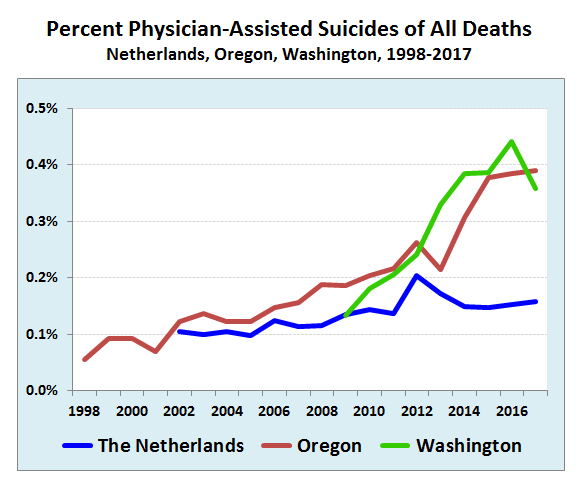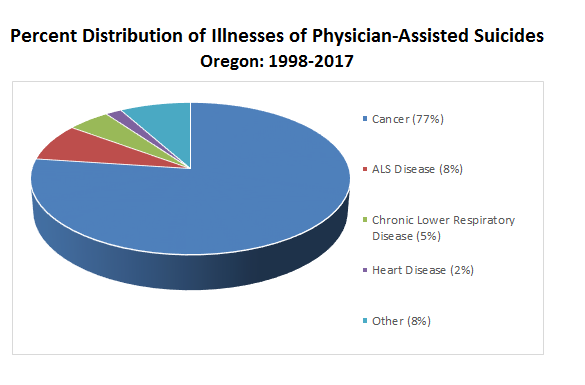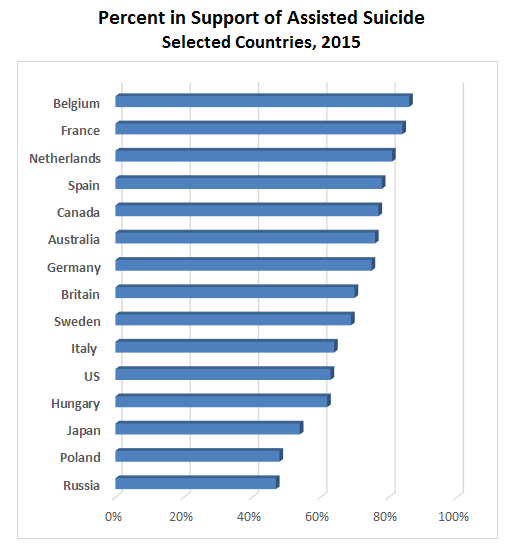Assisted Suicide: Human Right or Homicide?
Assisted Suicide: Human Right or Homicide?

NEW YORK: Death is an inevitable outcome for everyone. How one dies is a legitimate matter of concern for individuals and families, one that governments and courts should address rather than avoid. Physician-assisted suicide represents a fraction of all types of suicide, which together account for approximately 1.4 percent of annual deaths worldwide. Despite low incidence, the action to voluntarily end one’s life poses a dilemma – is assisted suicide a human right to be permitted or a homicide to be prohibited?
In contrast to euthanasia, by which medical practitioners oversee a procedure that ends a person’s life to relieve intractable suffering, assisted suicide typically involves a person choosing to end life through voluntary self-administration of a lethal dosage of drugs prescribed for that purpose. That distinction, however, is not always clear, especially when the person undertaking a suicide receives a physician’s aid directly or indirectly.

While suicide is a global phenomenon, with nearly 80 percent of suicides occurring in low- and middle-income countries, physician-assisted suicide has been allowed in only a few countries: Belgium, Canada, Colombia, Finland, Germany, Japan, Luxembourg, Netherlands, South Korea, Switzerland and the US states of California, Colorado, Hawaii, Montana, Oregon, Vermont and Washington as well as Washington, DC. The specific circumstances, diagnoses and requirements for the procedure vary among countries and states, and in general the guidelines are explicit and stringent, with approvals and responsibilities specified for patients and licensed medical authorities and protections for the mentally ill and incompetent.
The proportions of annual deaths reported as physician-assisted suicide are relatively low, typically less than a half of 1 percent. While proportions of assisted suicide have remained at those low levels, they have crept higher over time, as people become familiar with the procedure. For example, during the past two decades the proportion of deaths due to assisted suicides approximately doubled in the Netherlands, tripled in Washington and quadrupled in Oregon.
The most common illness of patients turning to physician-assisted suicide is all cancers combined, often followed in second place by amyotrophic lateral sclerosis, or ALS. In Oregon, for example, 77 percent of those electing assisted suicide during the period from 1998 to 2016 had cancer and 8 percent had ALS. Similar cancer rates among patients deciding on assisted suicide were reported in Belgium, 69 percent; Canada, 63 percent; the Netherlands, 71 percent; and the US states of California, 68 percent; Colorado, 64 percent; Vermont, 83 percent; and Washington state, 72 percent.
In general, the patients who decide on the procedure are motivated by symptoms, decreased quality of life and autonomy, a loss of sense of self and fears about the future. While each personal assessment is patient-specific, many who decide on suicide expect to relieve their suffering permanently and alleviate the burden for families and friends.
Some people travel far or relocate for the purpose of physician-assisted suicide. A few years ago, 29-year old Brittany Maynard with terminal brain cancer moved from California to Oregon to end her life. Recently, 104-year old David Goodall with diminished independence flew from his home in Australia to Switzerland to end his life. The issue was also popularized in the 2016 drama-comedy film, Youth in Oregon, in which an 80-year old terminally ill man travels by car from New York to Oregon for assisted suicide.

Most major religions, including Buddhism, Christianity, Hinduism, Islam, Judaism, oppose physician-assisted suicide. Among the Abrahamic religions, the opposition rests largely on the basic principle that life is sacred and only God, not the individual, should determine when their life ends. In Buddhism and Hinduism, suicide conflicts with their belief in karma and reincarnation. Religious opposition to assisted suicide, however, is not universal. The United Church of Christ and Unitarian Universalist Association affirm that individuals have the right to choose physician-assisted suicide and hold beliefs that God would favor ending suffering from a terminal illness.
The positions of physicians and professional medical organizations concerning assisted suicide vary, too. At the most general level, however, the divide among physicians on the sensitive and difficult issue of assisting a patient to commit suicide is between two fundamental medical principles: “do no harm” versus “relieve suffering.”
Some contend that the Hippocratic oath and medical ethics prohibit physicians from giving deadly drugs to anyone who asks. The American Medical Association and the American College of Physicians, for example, suggest that physician-assisted suicide is incompatible with the physician’s role as healer. In addition, those organizations argue that assisted suicide is difficult to control, poses serious societal risks and creates a slippery slope likely resulting in involuntary euthanasia. Others counter that the Hippocratic oath has been modified over time, and “do no harm” works both ways, suggesting it “harm” to prolong suffering. They point out that legalization in various jurisdictions has not been difficult to manage or control, neither posing serious societal risks nor creating a slippery slope. Moreover, in response to opposition of US medical associations, supporters note that 57 percent of American physicians support the option for the terminally ill.

Despite the proscriptions of major religious groups and lack of consensus among medical practitioners, large portions of the general public support physician-assisted suicide: In 13 of 15 countries surveyed in 2015, more than half of those interviewed supported legalization; the only exceptions were Poland and Russia, where slightly less than half said it should be legal. Another large-scale opinion survey covering 34 cities in China conducted several years ago found that more two-thirds of those polled do not object to euthanasia or assisted suicide. Available time-series survey data also point to increasing public support for physician-assisted suicide. In the United States and the United Kingdom, for example, polls conducted over the past 30 years show consistent majorities and growing support for assisted suicide, especially when the patient has an incurable disease or lives in severe pain.
Proponents argue that it is a basic human right to choose a timely and dignified death, especially for the terminally ill. Opponents contend that medical assistance in committing suicide does not constitute a fundamental human right, and palliative care and hospice can relieve pain and suffering. Another issue raised in the debate is that increased longevity and medical advances can delay death. Some patients fear that their lives may be prolonged unnecessarily or end in unbearable distress. Decisions by patients regarding the end of their life, it is argued, are personal decisions that governments should respect. Those who disagree maintain that government has a legitimate responsibility to protect life and restrict medical professionals and others from participating in actions to shorten a patient’s life.
Most people wish to die at home, avoiding a painful and burdensome end of life. Only20 percent of Americans die at home. Many say that rather than experiencing a long, drawn-out, emotionally and financially costly death in a medical facility with multiple interventions, they prefer a peaceful and painless death at home with dignity, a sense of emotional wellbeing and control over how people will remember them.
Societies should not avoid or dismiss the option. The emotional stresses of terminal illness and deciding on suicide are immense. A sibling and a close friend attempted suicide, with the friend eventually electing physician-assisted suicide, and I can assure readers that the consequences of end-of-life decisions extend well beyond the individual involved, with repercussions for family members, friends, colleagues and even distant acquaintances.
The debate is unlikely to be resolved soon. Still, a consensus may be slowly emerging. The compelling experiences in the small number of lead countries, public opinion trends and the concerns of the terminally ill point to decriminalization of assisted suicide with governmental and medical oversight and safeguards.
Joseph Chamie is an independent consulting demographer and a former director of the United Nations Population Division.
Comments
Correction please: Thankfully like 44 other states, no one in Montana has immunity from prosecution for assisting a suicide, no doctor, nurse, caregiver, guardian or corporation.
The promoters of assisted suicide have done you a disservice. The euthanasia mon0p0ly has worn out their thesaurus attempting to imply that it is legal in Montana. Assisted suicide is a homicide in Montana. Our Montana Supreme Court did rule that if a doctor is charged with a homicide they might have a potential defense based on consent. The court acknowledged it is a homicide in the ruling
The court did not address civil liabilities and vacated the lower court’s claim that it was a constitutional right. Unlike Oregon, no one in Montana has immunity from civil or criminal prosecution, death certificates are not legally falsified and investigations are not prohibited like in Hawaii, Colorado, Oregon, Washington and California. Does that sound legal to you?
Perhaps the promoters are frustrated that even though they were the largest lobbying spender in Montana, their Oregon model legalizing assisted suicide bills have been rejected in Montana in 2011, 2013 and 2015. The predatory corporation withdrew from their bullying legislative position in 2017. They simply did not try a fourth time and we celebrate saving lives every day in Montana.
What else have they spoke out of the side of their mouth?
— Bradley Williams, President, Montanans Against Assisted Suicide, Hamilton, Montana
Notice you have no statistics on Montana, hmmmmm.
Here you go, Bradley: https://www.deathwithdignity.org/states/montana/
in considering the legalization of physician assisted suicide, we choose between two things: Letting a very small number of mostly white, educated, affluent people kill themselves because they need to have control...or putting a vastly larger number of vulnerable people at risk for dying from mistake, abuse, and coercion. I strongly feel that society’s obligation to protect the vulnerable far outweighs its duty to autonomy. Suicide is not illegal and people can stop all treatments and go home at any time. This is about dragging doctors into their desire for control. Yes, it means denying those few the right to kill themselves. The medical community needs to step up its work in palliative care rather than succumb to the demand that they give their patients the means to kill themselves.
How does being free to go home help in alleviating suffering? Because those people are now free to risk having a botched suicide and suffer even more? Your empathy is overwhelming.
What's also amazing is that you claim to know the motivation of the people involved in wanting assisted suicide. Prove it or admit it's merely an opinion.
And here is where people will argue just for the sake of arguing. Christopher my lad your statement is ridiculous and for the same reason you chose to comment and belittle this guys opinionated writing. That seem blatantly clear to me but I guess not all of us got that. Christopher you said you were amazed by how this guy claimed he knew the motivation for these people and you just want proof or admit its an opinion. As they say the proof is in the pudding so I'll say to you. I'm amazed that Christopher would even claim that those people didn't use that as their motivation.... C'mon man really? Thats what you got out of that article?
I would like to know what you were thinking when you wrote this. You sound like the kind of person to have your loved one In pain and barely alive because of a machine and you wont just let them pass on.... Some people can't get the help that they need and they are just walking piles of pain. Assisted suicide is a safe thought for some people because they think that if it's too much that they can end it all. Why do you think people cut? They finally feel like they have the controls they have always wanted. They also get to chose their death and they get the option to make peace with everyone and themselves before they die and to show the people that they love that they love them. Assisted suicide does hurt people but everyone died at some point and some people die sooner then others. So I'm sorry to tell you this but you need to put on your big boy pants and realize that this is the broken world that we live in and not everyone will survive as long as we want them to so we should cherish the time we have our loved ones because the might be gone tomorrow. They might get cancer, the might get hit by a car, and just maybe they will take their own life. I'm sorry but you need to grow up.